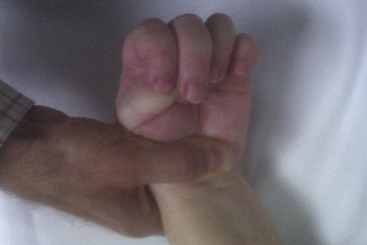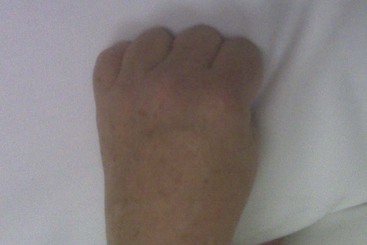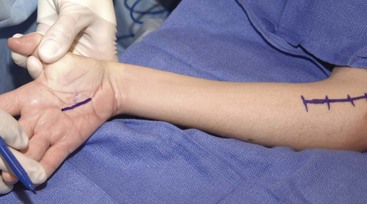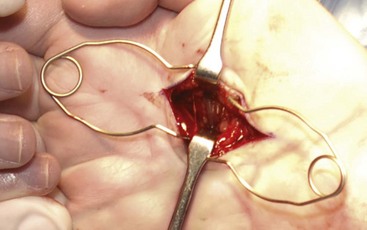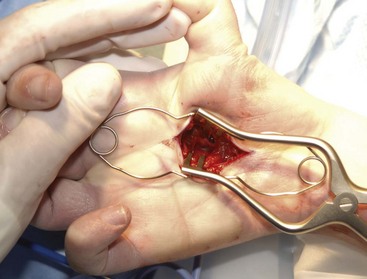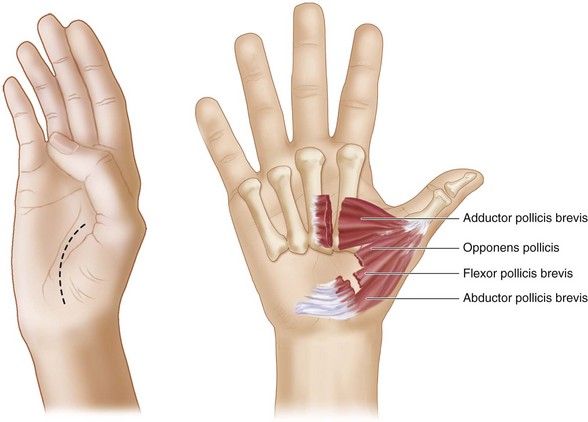Procedure 22 Intrinsic Muscle Release for Thumb-in-Palm Deformity
Indications
 Spastic contracture of the thumb adductor muscle results in excessive thumb metacarpal adduction and thumb-in-palm deformity.
Spastic contracture of the thumb adductor muscle results in excessive thumb metacarpal adduction and thumb-in-palm deformity.
 In mild or moderate degrees, grasp and pinch are affected when other intrinsic and extrinsic contractures result in compromise of skin care and hygiene.
In mild or moderate degrees, grasp and pinch are affected when other intrinsic and extrinsic contractures result in compromise of skin care and hygiene.
 This procedure is often combined with other surgical release procedures for the thumb, fingers, and wrist.
This procedure is often combined with other surgical release procedures for the thumb, fingers, and wrist.
Examination/Imaging
Clinical Examination
 Examination of the hand demonstrates an adducted position of the thumb metacarpal across the palm of the hand (Figs. 22-1 and 22-2).
Examination of the hand demonstrates an adducted position of the thumb metacarpal across the palm of the hand (Figs. 22-1 and 22-2).
 Additional deformities of the wrist and hand frequently can coexist with the thumb-in-palm deformity (Fig. 22-3).
Additional deformities of the wrist and hand frequently can coexist with the thumb-in-palm deformity (Fig. 22-3).
 Evaluate for flexion deformities of the thumb metacarpophalangeal joint and/or thumb interphalangeal joint, which would require concomitant releases of the flexor pollicis brevis or flexor pollicis longus, respectively.
Evaluate for flexion deformities of the thumb metacarpophalangeal joint and/or thumb interphalangeal joint, which would require concomitant releases of the flexor pollicis brevis or flexor pollicis longus, respectively.
Exposures
 A palmar incision is made paralleling the thenar crease (Fig. 22-4).
A palmar incision is made paralleling the thenar crease (Fig. 22-4).
 The long finger flexor tendons are the next most dorsal structure after the palmar fascia has been divided. Retract the flexor tendons ulnarly.
The long finger flexor tendons are the next most dorsal structure after the palmar fascia has been divided. Retract the flexor tendons ulnarly.
 Identify the lumbrical muscle and common digital artery and nerve.
Identify the lumbrical muscle and common digital artery and nerve.
 Gently retract the lumbrical muscle and the neurovascular bundle ulnarly to visualize the enveloping thumb adductor muscle fascia. The thumb adductor muscle, with transverse muscle fibers beneath, originates on the radial side of the long finger metacarpal (Fig. 22-5).
Gently retract the lumbrical muscle and the neurovascular bundle ulnarly to visualize the enveloping thumb adductor muscle fascia. The thumb adductor muscle, with transverse muscle fibers beneath, originates on the radial side of the long finger metacarpal (Fig. 22-5).
Procedure
Step 1
Step 2
 If necessary, proceed to release of thenar muscle contracture.
If necessary, proceed to release of thenar muscle contracture.
 Origins of both heads of flexor pollicis brevis, opponens pollicis, and abductor pollicis brevis muscles are identified on the volar carpal ligament and sharply sectioned with care (Fig. 22-7).
Origins of both heads of flexor pollicis brevis, opponens pollicis, and abductor pollicis brevis muscles are identified on the volar carpal ligament and sharply sectioned with care (Fig. 22-7).
 Again, passively abduct and extend the thumb, allowing the muscles to retract.
Again, passively abduct and extend the thumb, allowing the muscles to retract.
Step 2 Pearls
Preserve the motor branch of the median nerve to the thenar muscles.
The first dorsal interosseous muscle can be released from the thumb metacarpal base if residual contracture remains; however, this is usually not necessary.
Pin the thumb metacarpal in abduction with smooth K-wires if tightness persists.
Postoperative Care and Expected Outcomes
 The postoperative thumb-spica splint is applied with the thumb metacarpal positioned in extension and abduction. This permits the fibrosis that bridges the muscle defect to incorporate in a better anatomic position. Avoid thumb metaphalangeal hyperextension.
The postoperative thumb-spica splint is applied with the thumb metacarpal positioned in extension and abduction. This permits the fibrosis that bridges the muscle defect to incorporate in a better anatomic position. Avoid thumb metaphalangeal hyperextension.
 After 4 weeks, the patient is converted to a full-time fabricated C-splint between the index metaphalangeal joint and the thumb proximal phalanx. This holds the thumb in extension and abduction and maintains opening of the first web space. The splint is removed for bathing and exercises.
After 4 weeks, the patient is converted to a full-time fabricated C-splint between the index metaphalangeal joint and the thumb proximal phalanx. This holds the thumb in extension and abduction and maintains opening of the first web space. The splint is removed for bathing and exercises.
 Eight to 10 weeks postoperatively, the patient is advanced to wearing the splint at night only. If the patient is skeletally mature, the splint can be discontinued 3 to 6 months postoperatively.
Eight to 10 weeks postoperatively, the patient is advanced to wearing the splint at night only. If the patient is skeletally mature, the splint can be discontinued 3 to 6 months postoperatively.

